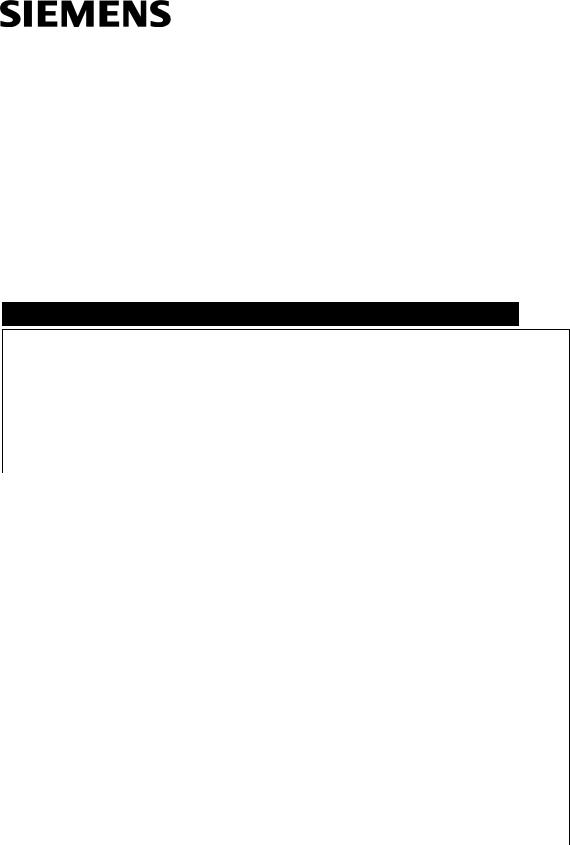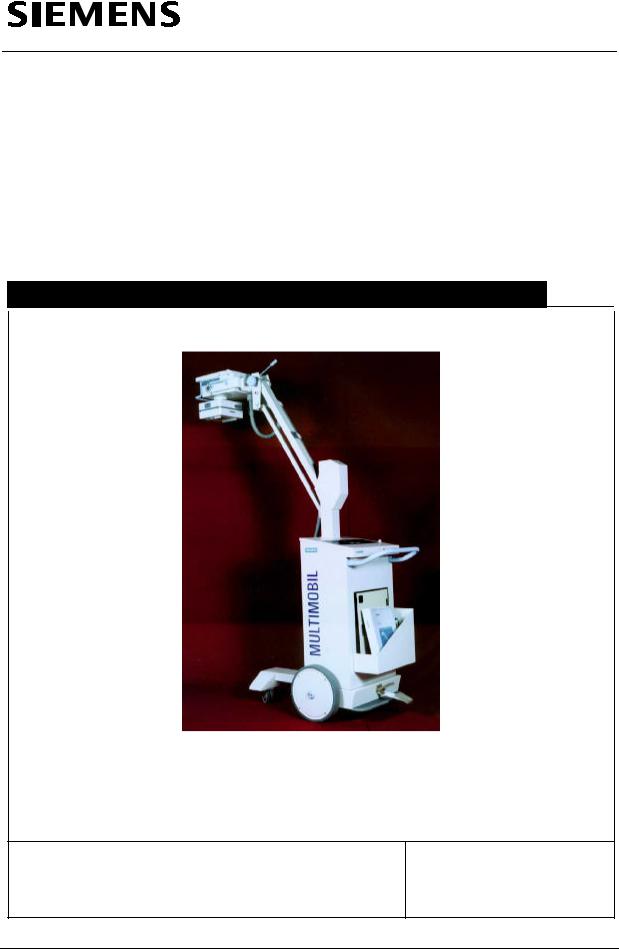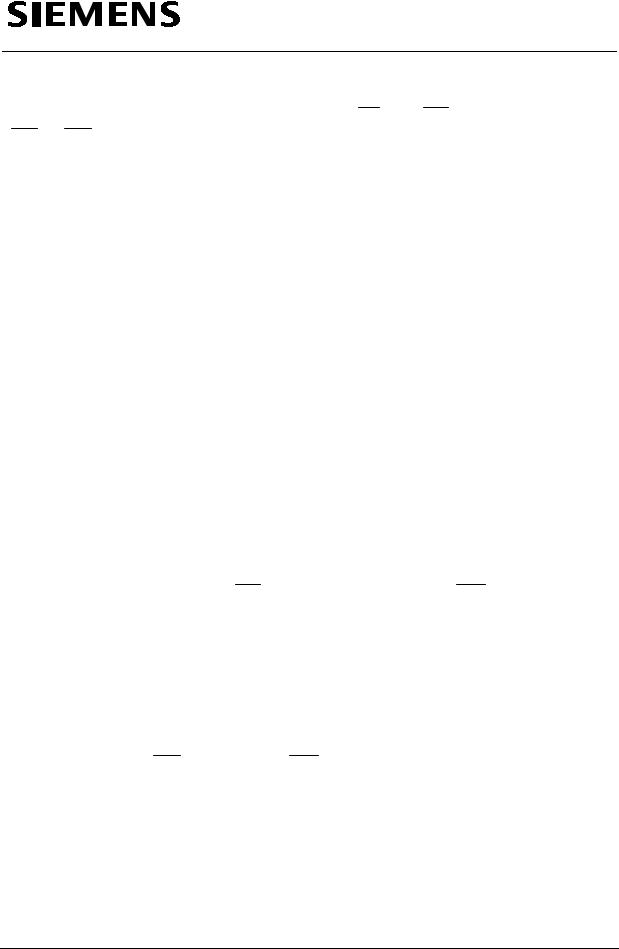Siemens MULTIMOBIL 2.5 User manual

MULTIMOBIL 2.5
SP
Function Description
|
|
|
|
|
|
|
|
|
|
|
|
© Siemens AG 2003 |
||
|
|
The reproduction, transmission or |
||
|
|
use of this document or its contents |
||
|
|
is not permitted without express |
||
|
|
written authority. Offenders will be |
||
|
|
liable for damages. |
All rights, |
|
|
|
including rights created by patent |
||
|
|
grant or registration of a utility |
||
|
|
model _or_ design,_are_ reserved. |
||
|
|
English |
|
|
|
Print No.: SPR8-X01.850.01.02.02 |
Doc. Gen. Date: |
09.05 |
|
Replaces: SPR8-X01.850.01.01.02

Service Manual
Circuit Description
Multimobil 2.5
Med
Circuit Description
Version: 6.0
Copyright © SIEMENS LTD.,MED INDIA
The reproduction, transmission or use of this document or its contents is not permitted without express written authority. Offenders will be liable for damages.
Siemens Ltd. Med India |
Version 6.0 |
6-1 |
|
|
Copyright © SIEMENS LTD. All rights reserved. For internal use only

Service Manual
Circuit Description
INDEX
6 |
CIRCUIT DESCRIPTION ................................................................................................... |
6-3 |
|
6.1 |
MASTER CARD D915 ....................................................................................................... |
6-3 |
|
6.1.1 |
Power Supply........................................................................................................ |
6-3 |
|
6.1.2 |
RESET Generation................................................................................................ |
6-3 |
|
6.1.3 |
Crystal Operation .................................................................................................. |
6-3 |
|
6.1.4 |
Microcontroller ...................................................................................................... |
6-3 |
|
6.1.5 |
Octal Latch........................................................................................................... |
6-3 |
|
6.1.6 |
GAL..................................................................................................................... |
6-3 |
|
6.1.7 |
EPROM................................................................................................................ |
6-4 |
|
6.1.8 |
NVRAM................................................................................................................ |
6-4 |
|
6.1.9 |
Serial Communication............................................................................................ |
6-4 |
|
6.1.10 |
Keyboard.............................................................................................................. |
6-4 |
|
6.1.11 |
Display................................................................................................................. |
6-4 |
|
6.1.12 |
kVsoll and mAsoll................................................................................................. |
6-4 |
|
6.1.13 |
Line voltage monitoring .......................................................................................... |
6-4 |
|
6.1.14 |
kV Feedback ....................................................................................................... |
6-5 |
|
6.1.15 |
IH Feedback ........................................................................................................ |
6-5 |
|
6.1.16 |
mA Feedback....................................................................................................... |
6-5 |
|
6.1.17 |
kV Regulation....................................................................................................... |
6-5 |
|
6.1.18 |
Filament Regulation............................................................................................... |
6-6 |
|
6.1.19 |
mAs Integration .................................................................................................... |
6-6 |
|
6.1.20 |
Control of the Firing Pulse Frequencies REG and CAL ............................................. |
6-6 |
|
6.1.21 |
Generation of actual Firing Signals ......................................................................... |
6-6 |
|
6.1.22 |
kVmax, mAmax Feedback .................................................................................... |
6-7 |
|
6.2 |
IGBT INVERTER ASSEMBLY D61.......................................................................................... |
6-7 |
|
6.2.1 |
Firing ................................................................................................................... |
6-7 |
|
6.2.2 |
Inverter................................................................................................................. |
6-8 |
|
6.2.3 |
SCM .................................................................................................................... |
6-9 |
|
6.3 |
INTERFACE PCB D920 ................................................................................................... |
6-10 |
|
6.3.1 |
ON/OFF Circuit................................................................................................... |
6-10 |
|
6.3.2 |
Line voltage measurement ................................................................................... |
6-10 |
|
6.3.3 |
Power Supply Distribution .................................................................................... |
6-10 |
|
6.3.4 |
Filament Circuit................................................................................................... |
6-11 |
|
6.3.5 |
Filament Supply and Heating................................................................................ |
6-11 |
|
6.3.6 |
Stand-by State.................................................................................................... |
6-11 |
|
6.3.7 |
Preparation State................................................................................................ |
6-11 |
|
6.3.8 |
Filament Current Feed Back ................................................................................ |
6-11 |
|
6.3.9 |
Tube Current Feedback....................................................................................... |
6-12 |
|
6.3.10 |
Collimator Supply................................................................................................ |
6-12 |
|
6.4 |
KEYBOARD PCB D936 .................................................................................................. |
6-12 |
|
6.4.1 |
Keypad............................................................................................................... |
6-12 |
|
6.4.2 |
Interface with Master Card.................................................................................... |
6-12 |
|
6.5 |
DISPLAY PCB D932...................................................................................................... |
6-13 |
|
6.5.1 |
Connections ....................................................................................................... |
6-13 |
|
6.5.2 |
Interface with Master Card.................................................................................... |
6-13 |
|
6.6 |
SWITCH MODE POWER SUPPLY 40 WATTS.......................................................................... |
6-13 |
|
6.6.1 |
Specifications ..................................................................................................... |
6-13 |
|
6.7 |
SWITCH MODE POWER SUPPLY 120 WATTS ........................................................................ |
6-14 |
|
6.7.1 |
Specifications ..................................................................................................... |
6-14 |
|
Error! No index entries found. |
|
|
|
|
|
|
|
Siemens Ltd. Med India |
Version 6.0 |
6-2 |
|
|
|
|
|
Copyright © SIEMENS LTD. All rights reserved. For internal use only

Service Manual
Circuit Description
6 Circuit Description
6.1Master Card D915
6.1.1 Power Supply
The +15, 0V, -15V and +5V, 0V voltages are obtained from the SMPS through the connector X15.
The reference voltage for the Microcontroller (J31) is 5V and it is generated by R119, C85, and J30.
6.1.2 RESET Generation
The RST signal is generated by IC J40 (MAX700 : power supply monitor with reset) at power ON. The switch SW2 also allows for manual reset of the system.
On actuating SW2 ON, reset is generated by J40 which is applied to RST of J31.
6.1.3 Crystal Operation
The 12 MHz Quartz crystal forms a Pierce Oscillator along with the two capacitors C93 and C95. The output of the oscillator is a 12MHz sinusoidal wave which is applied to XTAL1 and XTAL2 inputs of J31 for providing timings for internal operations of the microcontroller.
6.1.4 Microcontroller
The microcontroller J31 outputs multiplexed lower order address bus and the data bus on port ‘P0’ and higher order address bus on port ‘P2’.
The control signal RD , WR along with A8-A15 are provided to J28 (GAL) to generate the chip select signals for accessing various peripherals.
The status signal PSEN is used for reading external program stored in EPROM J32. The EA ‘LOW’ allows accessing the external program memory.
Different signals for controlling various operations of the entire system are provided by the Microcontroller on its ports P1, P3, P4, P5.
The analog inputs AN0 - AN6 are used for monitoring analog signals.
The pins TxD and RxD are used for serial communication between the processor and the external device such as a Computer for servicing.
The Service switch ST provided at pin P4.5 is used for operating the Unit in the service mode.
6.1.5 Octal Latch
The multiplexed address and the data bus is separated by the octal latch J27. At the active ALE signal, the lower order address (A0-A7) is latched.
6.1.6 GAL
Since Memory mapping technique is used, the chip select signals for various peripheral devices are generated by the Gated Array Logic IC J28. The inputs are the
Siemens Ltd. Med India |
Version 6.0 |
6-3 |
|
|
Copyright © SIEMENS LTD. All rights reserved. For internal use only

Service Manual
Circuit Description
address lines (A8 - A15), and the control signals RD and WR . The output lines are CS1 to CS8 .
These output chip select lines are generated on the basis of the logic implemented in the program stored in the GAL.
6.1.7 EPROM
The entire program is stored in a single EPROM J32.
6.1.8 NVRAM
The 2 Kbyte NVRAM stores the variables during the opertion of the unit.
A0 - A10 and D0 - D7 are the address and the data lines provided to the RAM. The first 2K bytes of entire memory space 0000H to 07FFH is used as RAM.
6.1.9 Serial Communication
TxD, RxD are provided to the serial communication port of D915. Various activities of the unit can be controlled by an external device such as a PC. The serial port is meant for testing and service purposes.
6.1.10 Keyboard
The keys are accepted through X12 from D936.
The keys kV+ , kV -, mAS+, mASare accepted on the data bus through J38 and J37 at the address 9000H.
The ON, OFF signals are routed via X12, D915, X10 to D920.
6.1.11Display
The data bus, the control signal WR and the chip select signal CS2 are provided to the Display Driver J24 on D932 through X1. Writing the control word and the string of 8 byte data at the addresses 8000H and 8800H respectively displays the kV and mAS values and lights up function related LEDs on D915.
6.1.12kVsoll and mAsoll
The kVsoll and mAsoll values are generated by Dual Digital to Analog Converter J17 and the Opamp J13 acting as I - V converter.
The microcontroller J31 outputs the digital values of kVsoll and mAsoll on the data bus at address A000H (CS3) and A100H (CS4 ) respectively. The reference current for DAC is adjusted by means of presets P6 and P7.
The kVsoll and mAsoll are fed back to the AN3 and AN4 pins of J31 for ensuring their proper values. These soll values are also used for regulation of kV and mA.
The kV soll ratio is 1 V = 30 kV and the mAsoll ratio is 1 V = 20 mA.
6.1.13 Line voltage monitoring
The actual mains Line voltage stepped down & converted to DC and through differential amplifier it is fed to V-Bat input point of ADC . This DC voltage is monitored every 5 second in standby mode of unit and line voltage is displayed
Siemens Ltd. Med India |
Version 6.0 |
6-4 |
|
|
Copyright © SIEMENS LTD. All rights reserved. For internal use only
